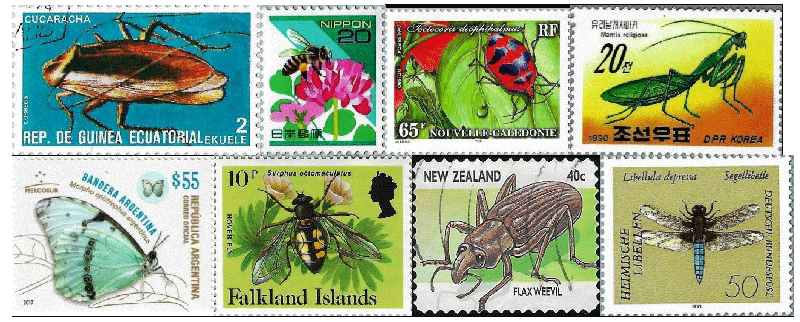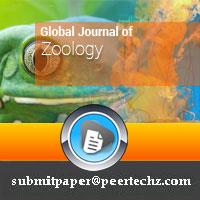Global Journal of Zoology
Stamps as a cultural value related to the biodiversity of insects
Paola Turienzo*
Black River Bariloche, School of Agricultural Production, National University of Río Negro, Andean Headquarters, Argentina
*Corresponding author: Paola Turienzo, Black River Bariloche, School of Agricultural Production, National University of Río Negro, Andean Headquarters, Argentina, E-mail: pnturienzo@unrn.edu.ar
Received: 05 October, 2020 | Accepted: 15 May, 2023 | Published: 16 May, 2023
Cite this as
Turienzo P (2023) Stamps as a cultural value related to the biodiversity of insects. Glob J Zool 8(1): 001-002. DOI: 10.17352/gjz.000025
Copyright
© 2023 Turienzo P. This is an open-access article distributed under the terms of the Creative Commons Attribution License, which permits unrestricted use, distribution, and reproduction in any medium, provided the original author and source are credited.
Biodiversity has been studied by many specialists and is the same as the terminology “biological diversity” with more than 1.8 million species with Latin name (Scientific name). The insects as a big group have between 751.000 to 950.000 species [1]. Recently, with molecular characterization, some groups get a different point of view [2-4]. This biodiversity could be found by orders [5] in the real world and in the cultural world like stamps [6]. Insects in stamps have been studied by many scientists around the world, with different points of view. This aspect is one of the ethnoentomological studies and is called Entomophilately. In the last years, many studies related to insects biodiversity in stamps has been published principally on Lepidoptera and Coleoptera, in some cases, in some minority groups and special species as some Coleoptera from caves [6-17]. Most of these works were related to biodiversity richness and are important to reflect the cultural significance of countries to show to other parts of the world.
From a formal education point of view, postage stamps have been used to inform the teaching of entomology [18].
This little note has the intention to awaken the intellectual curiosity of entomologists or the general public who may be interested in the study of insects, their diversity, and their significance, in postage stamps. (This work was written in times of pandemic when could be appropriated. In the middle, an interesting work appears about this theme [19].
- Pascual Trillo Ja. The loss of biodiversity. In: Terrestrial systems and their environmental implications. Ministry of Education and Science (Summer Classrooms, El Escorial). 2003; 205-222.
- Islam SU, Qasim M, Lin W, Islam W, Arif M, Ali H, Du Z, Wu Z. Genetic interaction and diversity of the families Libellulidae and Gomphidae through COI gene from China and Pakistan. Acta Trop. 2018 Jun;182:92-99. doi: 10.1016/j.actatropica.2018.02.016. Epub 2018 Feb 15. PMID: 29454732.
- Islam SU, Qasim M, Ali H, Islam W, Arif M, Dash CK, Lin W, Du Z, Wu Z. Genetic diversity of the families Aeshnidae, Gomphidae and Libellulidae through COI gene from South China. Acta Trop. 2018 Sep;185:273-279. doi: 10.1016/j.actatropica.2018.06.004. Epub 2018 Jun 8. PMID: 29890154.
- Munawar K, Saleh A, Afzal M, Qasim M, Khan KA, Zafar MI, Khater EI. Molecular characterization and phylogenetic analysis of anopheline (Anophelinae: Culicidae) mosquitoes of the Oriental and Afrotropical Zoogeographic zones in Saudi Arabia. Acta Trop. 2020 Jul;207:105494. doi: 10.1016/j.actatropica.2020.105494. Epub 2020 Apr 21. PMID: 32330453.
- Melic A, Ribera I. biological chronodiversity. Aragonese Entomological Society Bulletin. 1996; 16:189-206.
- Palacios-Vargas JG, Navarrete-Heredia JL. Entomophilately, an aspect of cultural Entomology. In: Biodiversity, taxonomy and biogeography of arthropods from Mexico: Towards a synthesis of their knowledge. Conabio-Unam. 2003; 3:107-115.
- Costa Neto EM. Entomophilately: Insects in philatelic art. Bioikos. 2002; 16(1/2): 61-67.
- Gómez y, Gómez B, Junghans C. The Scaraboideae (Insecta: Coleoptera) in philately. biodiversity notebooks, 2002; 10-14.
- Mendoza Ramírez M, Pacheco Rueda I, Sarmiento Cordero MA, Zurita García ML. Entomophilately in Mexico: tribute to the friendship of insects. Aragonese Entomological Society. 2006; 38: 443-449.
- Palacios-Vargas JG. Entomofilatelia: Postage stamps with insects and other arthropods in the world. In: Navarrete-Heredia, J.L., G. Castaño Meneses & G.A. Quiroz-Rocha (Eds.). Facets of Science: Essays on Cultural Entomology. University of Guadalajara. 2011; 15-16.
- Ocampo FC. Argentine Entomological Stamps. Sea Newsletter. 2012; 23 (1): 8-9.
- Turienzo P, Alves Carneiro W. Insects of the family Carabidae (Ground Beetles) in world philately. biological. 2014; 17: 77-78.
- Gómez B, Domínguez MR, Junghans C. Cockroaches (Blattodea) represented on postage stamps (entomophilately). In: Castaño-Meneses, G. & J.L. Navarrete-Heredia (coords.) Advances in Mexican Cultural Entomology UNAM-CUCB: University of Guadalajara. 2015; 77-82.
- Turienzo P. Bioespeleofilatelia: Clivina subterranea (Coleoptera: Carabidae). EspeleoAr, 2018a ;18: 15-16.
- Rapauch MJ. Endeless forms most beautiful-Ground beetles (Coleoptera, Carabidae) on postal stamps. Angewandle Carabidologie. 2018; 12:29-35.
- Hernández-Baltazar E,Gómez B. Mantodea in philately (Insecta: Dictyoptera). Dugesian. 2019; 26(2):71-76.
- López-Díaz jA, Gómez B. Los Odonata (Insecta) in entomophilately. Dugesiana. 2020; 27(1): 3-10.
- Turienzo P. The teaching of entomology through postage stamps as a didactic resource. idea. 2018b; 36(3): 119-129.
- Nazari V.Taxonomy at Face Value: An assessment of entomological postage stamps as effective teaching aids for science educators. Research Ideas and Outcomes. 2021; 7: e68056.
Cite this as
Turienzo P (2023) Stamps as a cultural value related to the biodiversity of insects. Glob J Zool 8(1): 001-002. DOI: 10.17352/gjz.000025Copyright
© 2023 Turienzo P. This is an open-access article distributed under the terms of the Creative Commons Attribution License, which permits unrestricted use, distribution, and reproduction in any medium, provided the original author and source are credited.Biodiversity has been studied by many specialists and is the same as the terminology “biological diversity” with more than 1.8 million species with Latin name (Scientific name). The insects as a big group have between 751.000 to 950.000 species [1]. Recently, with molecular characterization, some groups get a different point of view [2-4]. This biodiversity could be found by orders [5] in the real world and in the cultural world like stamps [6]. Insects in stamps have been studied by many scientists around the world, with different points of view. This aspect is one of the ethnoentomological studies and is called Entomophilately. In the last years, many studies related to insects biodiversity in stamps has been published principally on Lepidoptera and Coleoptera, in some cases, in some minority groups and special species as some Coleoptera from caves [6-17]. Most of these works were related to biodiversity richness and are important to reflect the cultural significance of countries to show to other parts of the world.
From a formal education point of view, postage stamps have been used to inform the teaching of entomology [18].
This little note has the intention to awaken the intellectual curiosity of entomologists or the general public who may be interested in the study of insects, their diversity, and their significance, in postage stamps. (This work was written in times of pandemic when could be appropriated. In the middle, an interesting work appears about this theme [19].
- Pascual Trillo Ja. The loss of biodiversity. In: Terrestrial systems and their environmental implications. Ministry of Education and Science (Summer Classrooms, El Escorial). 2003; 205-222.
- Islam SU, Qasim M, Lin W, Islam W, Arif M, Ali H, Du Z, Wu Z. Genetic interaction and diversity of the families Libellulidae and Gomphidae through COI gene from China and Pakistan. Acta Trop. 2018 Jun;182:92-99. doi: 10.1016/j.actatropica.2018.02.016. Epub 2018 Feb 15. PMID: 29454732.
- Islam SU, Qasim M, Ali H, Islam W, Arif M, Dash CK, Lin W, Du Z, Wu Z. Genetic diversity of the families Aeshnidae, Gomphidae and Libellulidae through COI gene from South China. Acta Trop. 2018 Sep;185:273-279. doi: 10.1016/j.actatropica.2018.06.004. Epub 2018 Jun 8. PMID: 29890154.
- Munawar K, Saleh A, Afzal M, Qasim M, Khan KA, Zafar MI, Khater EI. Molecular characterization and phylogenetic analysis of anopheline (Anophelinae: Culicidae) mosquitoes of the Oriental and Afrotropical Zoogeographic zones in Saudi Arabia. Acta Trop. 2020 Jul;207:105494. doi: 10.1016/j.actatropica.2020.105494. Epub 2020 Apr 21. PMID: 32330453.
- Melic A, Ribera I. biological chronodiversity. Aragonese Entomological Society Bulletin. 1996; 16:189-206.
- Palacios-Vargas JG, Navarrete-Heredia JL. Entomophilately, an aspect of cultural Entomology. In: Biodiversity, taxonomy and biogeography of arthropods from Mexico: Towards a synthesis of their knowledge. Conabio-Unam. 2003; 3:107-115.
- Costa Neto EM. Entomophilately: Insects in philatelic art. Bioikos. 2002; 16(1/2): 61-67.
- Gómez y, Gómez B, Junghans C. The Scaraboideae (Insecta: Coleoptera) in philately. biodiversity notebooks, 2002; 10-14.
- Mendoza Ramírez M, Pacheco Rueda I, Sarmiento Cordero MA, Zurita García ML. Entomophilately in Mexico: tribute to the friendship of insects. Aragonese Entomological Society. 2006; 38: 443-449.
- Palacios-Vargas JG. Entomofilatelia: Postage stamps with insects and other arthropods in the world. In: Navarrete-Heredia, J.L., G. Castaño Meneses & G.A. Quiroz-Rocha (Eds.). Facets of Science: Essays on Cultural Entomology. University of Guadalajara. 2011; 15-16.
- Ocampo FC. Argentine Entomological Stamps. Sea Newsletter. 2012; 23 (1): 8-9.
- Turienzo P, Alves Carneiro W. Insects of the family Carabidae (Ground Beetles) in world philately. biological. 2014; 17: 77-78.
- Gómez B, Domínguez MR, Junghans C. Cockroaches (Blattodea) represented on postage stamps (entomophilately). In: Castaño-Meneses, G. & J.L. Navarrete-Heredia (coords.) Advances in Mexican Cultural Entomology UNAM-CUCB: University of Guadalajara. 2015; 77-82.
- Turienzo P. Bioespeleofilatelia: Clivina subterranea (Coleoptera: Carabidae). EspeleoAr, 2018a ;18: 15-16.
- Rapauch MJ. Endeless forms most beautiful-Ground beetles (Coleoptera, Carabidae) on postal stamps. Angewandle Carabidologie. 2018; 12:29-35.
- Hernández-Baltazar E,Gómez B. Mantodea in philately (Insecta: Dictyoptera). Dugesian. 2019; 26(2):71-76.
- López-Díaz jA, Gómez B. Los Odonata (Insecta) in entomophilately. Dugesiana. 2020; 27(1): 3-10.
- Turienzo P. The teaching of entomology through postage stamps as a didactic resource. idea. 2018b; 36(3): 119-129.
- Nazari V.Taxonomy at Face Value: An assessment of entomological postage stamps as effective teaching aids for science educators. Research Ideas and Outcomes. 2021; 7: e68056.
Article Alerts
Subscribe to our articles alerts and stay tuned.
 This work is licensed under a Creative Commons Attribution 4.0 International License.
This work is licensed under a Creative Commons Attribution 4.0 International License.



 Save to Mendeley
Save to Mendeley
